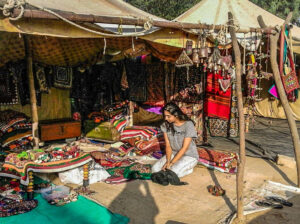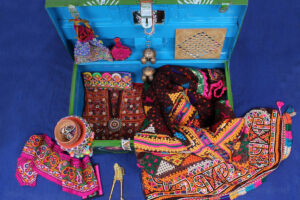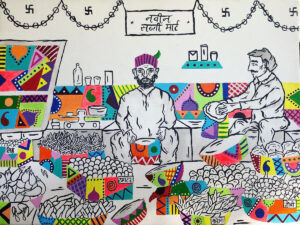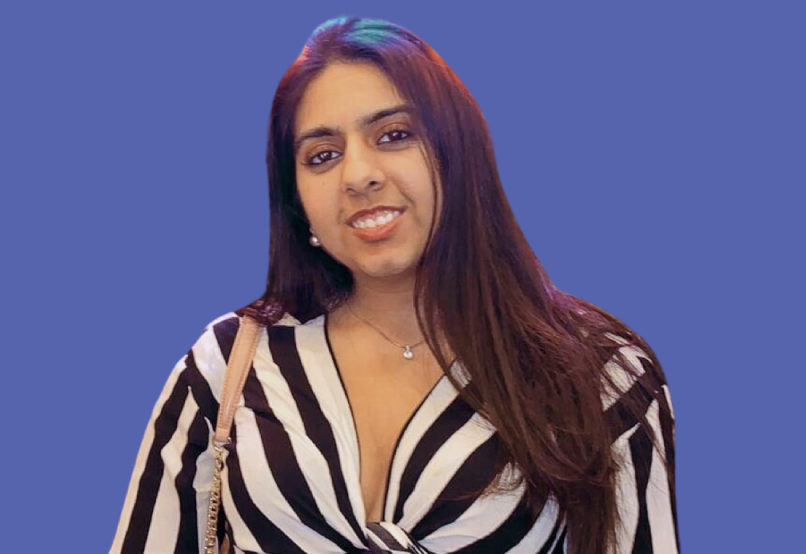Multidisciplinary Works with Shyamolie Madhavji
A few weeks ago I had a chat on the phone with multidisciplinary artist Shyamolie Madhavji. Her work is vibrant and colourful, and is redolent of traditional Indian works across textile, painting, and other mediums. Here is our conversation:
Alex – You’re in India at the moment aren’t you?
Shyamolie – Yes – I just studied in the UK for three years, and then because of covid I came back and now I’m here
A Is that your home for the foreseeable future?
S Yep for the future
A What made you choose the UK as a place to study in?
S Well actually I went to Bournemouth for a summer course when I was in high school, and I really enjoyed it, and I did a couple of courses – I studied fashion, graphic design, fine art, photography, film, and I just felt like the education there is very different to the education here especially with like fine art. I saw the creative field over there and I just thought it would be something different to study abroad, and I feel like I connected with the place, like as soon as I reached there I knew it was somewhere id love to go to university.
A You say fine art is taught quite differently over here – what’s your impression of the way it’s taught here compared to India?
S The thing is that when you study fine art in India, you have to do certain compulsory subjects like English, Psychology, Sociology – but in the UK your course would just be a BA Fine Art, and it would just be like whatever you want. Also, I feel like the creative team, like the studio time we have is much more there than you would get over here – so I think that’s one of the major things that made me choose Bournemouth instead of something in my hometown.
A It sounds like the Indian art education system isn’t set up to be that helpful to artists. Is shaping a career in that world difficult?
S No, I feel like the world of work is very different. When I came back, I had this impression that I’m going to get my own studio when I built a studio in a spare place that I found, and I started working from there really, and I started doing a couple of freelance projects, for like the London Design Biennale, then I was doing a couple of exhibitions in London – they were all virtual of course because of the pandemic – id did a few in London, some in Liverpool, and I’m also doing a few residencies online. So I was keeping myself busy with those things, and of course I did like a couple of features in like some magazines and online blogs. I also started doing set design as a freelance job, and actually now I’m working at an art gallery, and that’s been about three months. I feel like it’s a bit different but it’s something I enjoy doing.

A You feel like you’re very much open to different projects in the art world, you’re not limiting yourself to just one thing.
S Yeah I feel like once I graduated I just did a lot of things I found interesting like, very random things, like I started working with a set design company which is not really something that I thought of, its always like a hobby, but that just got me into a bit of freelancing for about 4 months and I had to drop it because it was taking up too much of my time. That is something, you know I’ve always enjoyed it, but I never thought I’d really pick it up since I graduated. Then I got an opportunity to work as a research and design assistant for the London Design Biennale which was also really interesting. I was just going with the flow, I didn’t really have any plan, they were just like I minted my first NFT in New York – I feel like things just happened and fell into place.
A NFTs are one of the most talked about things in the art world at the moment. Were they part of the conversation while you were still studying? I’d love to hear about how they were seen from a student or a lecturer’s perspective.
S Yeah, so actually the concept of NFTs was really confusing to me, and I just kind of wanted to know more about it, like one day i’ll figure it out – and then I got this opportunity from Every Woman Biennial, from the Superchief Gallery in New York. I got selected for an NFT exhibition, and I was like: “Oh wow, ill go ahead with this but I have no idea how it works, like what’s going to happen?”. I had like a week to make my MetaMask and things like that. So it was quite confusing but at the end of the day it’s like a learning experience, and you’ve got to learn these things. Superchief Gallery is one of the first NFT spaces in the world I think, so that was really interesting, interacting with artists who are exhibiting there, and the director of the gallery, the curator.
A Is that something that you’re able to earn money from passively now? Is it something that you plan on doing more of in the future?
S Yeah I hope so, I hope my other paintings, I hope to make those NFTs. It was actually one of my favourite ones, so I’m glad that happened.
A If we could just take a step backwards for a second, I’d like to know a bit about your early memories and first steps into the art world.
S Well I was always studying art, we had it as an extra subject, and I started it properly pursuing it at maybe 13 as an extra subject. I felt like I was always inspired by art because my aunt was working in design… a few of my other cousins and aunts who live in the UK, she’s also an artist as well, and my grandmother was an artist as well which is where I got my inspiration for textiles. The place I come from, my hometown, which is called Kutch, its a place in the northwest of India. I took a trip there to do some photography and get some inspiration for my portfolio. That was when I realised that was where my culture and tradition comes from, and that really inspired me to develop my style. I worked with a lot of craftsmen and artisans in a couple of villages, and I learnt a few different types of textile printing, block printing, and a few different art forms, which are like prominent in my style today. I feel like that was one turning point in my artistic journey which I really enjoyed, and this was when I was, say, like 16? So I think that was one thing that made me realise that – ok – I want to like you know, portray my culture and tradition through my artwork.
A Would you say that your artwork is firmly rooted in an Indian visual language?
S Yeah, I feel like it’s mainly influenced by the textile designs from my hometown, and like a few visual images from Mumbai which is where I’m living currently.

A When you came over here to study, did you find that your artwork took on much of an influence from the art and design around you, or was it just a case of honing your craft when you were here?
S Not really – I felt the inspiration but I didn’t include all that in my artwork – I feel like the people around me, like the people in my studio, id be inspired by their styles and their like themes of painting but I always stuck to my own style and inspirations.
A What would you like to offer up as your Who’s Flying the Plane? Hidden Gem?
S One artist would be Faig Ahmed, he’s a textile artist from Azerbaijan. All his work is based on cloth, fabric and textiles, and it’s also inspired by artisans and craftsmen from his hometown. I remember writing about him in my dissertation, because my topic was based on contemporary artists being inspired by textiles and designs. I think when I was reading his stories and about his personal relationship with the artisans, it really connected with me. Just reading about how he was fascinated as a child by carpets, textiles, cloth – and how he’d include them in his work and his installations… I think that was one of the most inspirational things I researched.
You can follow Shyamolie’s work on instagram here.


Interview by Alex Wilson